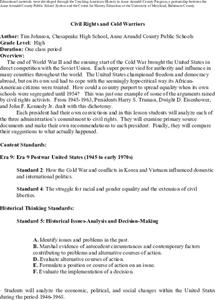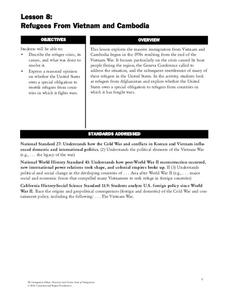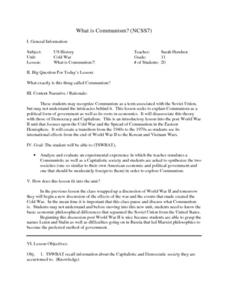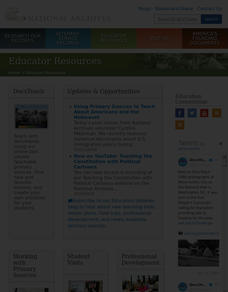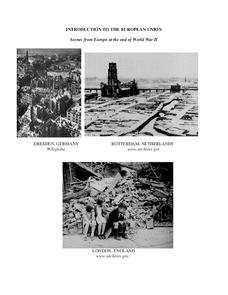Curated OER
W.A.R.M.E.R. Comprehension Worksheet
In this Cold War worksheet, students respond to 6 short answer questions regarding the end of the Cold War that feature the letters of the word "warmer" as mnemonic hooks.
Center for History Education
Civil Rights and Cold Warriors
Three presidents, three views on civil rights. Scholars compare the administrations of President Truman, Eisenhower, and Kennedy to understand how each addressed the issue of civil rights. The lesson plan uses primary sources and graphic...
Curated OER
The Consequences of World War II
Ninth graders explore the aftermath of World War II. In this World War II lesson, 9th graders investigate the consequences of the war as they complete a post-assessment project that requires them to compose essays on the topic.
Curated OER
1960 America: Foreign Policy
The 1960's marked shifts in American culture, politics, and policy. Your class groups up to research a series of primary source documents resulting in a timeline and a 15 minute oral presentation. Active learning all the way.
The New York Times
Kiev in Chaos: Teaching About the Crisis in Ukraine
Provide a historical context for the political unrest between Russia and Ukraine that began in late 2013. Learners review their prior knowledge and chronicle new understandings with a KWL chart, watch a video explaining the Ukrainian...
Curated OER
The Cold War Ends and Reagan Presidency
In this contemporary U.S. history worksheet, students read articles about the end of the Cold War as well as the Reagan presidency. Students then respond to 13 short answer questions.
Curated OER
Literature and the "Age of Anxiety" (1920s and 1930s).
Students examine historical events of the 1920s, World War II and the Cold War. They discover how literature reflects the economic, political, social, religious and historical concerns of a culture. Students compare literature writings...
Curated OER
The Arms Race - From the Beginning to the End
Ninth graders focus on the political and technological developments of the Cold War. They, in groups, read and summarize the speech they are given. They should provide a short presentation based on their interpretation.
Constitutional Rights Foundation
Refugees From Vietnam and Cambodia
The United States may have pulled its troops from the Vietnam War in 1973, but the conflict was far from over for the citizens living in Asia at the time. An informative resource lets learners know about the wave of over 220,000...
Core Knowledge Foundation
Volume 2 - A History of the United States: Modern Times—Late 1800s to the 2000s
The second volume of the Core Knowledge History of the United States ebook begins by asking young scholars to consider the impact immigration, industrialization, and urbanization had on the United States in the late 1800s. The text ends...
Curated OER
Enemy or Ally: America's Response to the Russian Revolution
Young scholars examine the events related to the Russian Revolution. In groups, they use the internet to discover the concerns of Woodrow Wilson during this time period and relate them to the origins of the Cold War. To end the lesson,...
Curated OER
The Tet Offensive and the Vietnam War
Students comprehend how the United States became involved in what one historian called the quagmire. Students identify and analyze the importance of the Tet Offensive in turning American public opinion against the Vietnam War. Students...
Curated OER
Dropping the Atomic Bomb: The Decision That Defined a Presidency
Students interpret historical evidence presented in primary and secondary resources. In this World War II lesson, students research the implications of the use of nuclear weapons to end the war in the Pacific. Students determine...
Curated OER
The Cold War Warrior Defending: The Moral Beacon of the World
High schoolers identify President Reagan's domestic and foreign policy, describe America's attitude toward communism, list characteristics which endeared Reagan to the American people, and explain why some Americans spoke out against...
Curated OER
End of Mandates and the Middle East
Ninth graders investigate the original mandates of the League of Nations regarding the Middle East. They listen to a lecture/PowerPoint presentation on the end of the mandate system, and complete a fill-in-the-blank worksheet that...
Curated OER
Police Action: The Korean War, 1950-1953
Learners explore why the United States became involved in the war in Korea. They discuss the confict between Truman and MacArthur, culminating in the latter's dismissal from command. They identify on a world map foreign countires...
Curated OER
What is Communism?
Eleventh graders explore Communism. They explore Communism's roots in economics and discuss the spread of Communism in the Eastern Hemisphere. They evaluate a Communistic and a Capitalistic society. Students reflect upon the positives...
Curated OER
The Role of Government
Young scholars are introduced to the economic roles of the federal government. Using the internet, they read information related to government spending and the actual dollar amounts attached to budget items. In groups, they develop...
Curated OER
Memorandum of a Conference with President Eisenhower after Sputnik
Students use the National Archives to research how the United States and the Soviet Union south to maintain its supremacy after World War II.
National Endowment for the Humanities
How "Grand" and "Allied" Was the Grand Alliance?
Learn more about the Grand Alliance with a scaffolded lesson plan that includes four activities. Class members use primary sources to complete a map exercise, understand the goals and objectives of each individual nation, and participate...
Delegation of the European Union to the United States
The Founding and Development of the European Union
How did Europe transition from a period of conflict to a period of sustained peace? As class members continue their study of the history and development of the European Union, groups examine the events in six time periods, from the...
Curated OER
Introduction To The European Union
A lot happened to European economics, policy, and social systems after WWII. This 24 page social studies packet provides images, reading passages, comprehension questions, and critical thinking questions regarding all things Europe from...
Student Handouts
Examining Primary Sources: Rudyard Kipling, “The White Man’s Burden” (1899)
Combine literature and history with the poem "The White Man's Burden" by Rudyard Kipling. Pupils read the poem and answer four questions about the text.
Curated OER
Troop Surge vs. Redeployment
Students explore American foreign policy regarding the war in Iraq. In this Iraq debate lesson, students examine videos and documents about the pros and cons of keeping American troops in Iraq.



